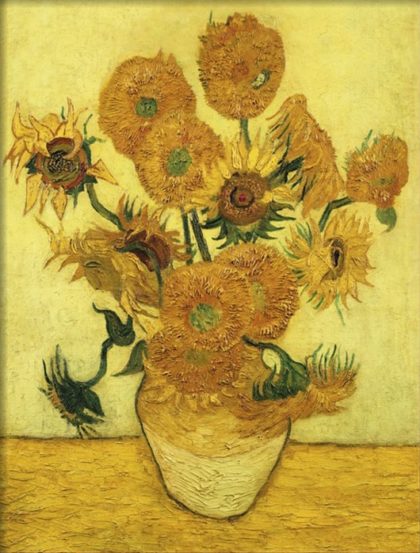The Sunflowers are a series of paintings by the Dutch post-impressionist painter Vincent Willem van Gogh, who lived from March 30, 1853 to July 29, 1890. This series, which consists of seven paintings in total, was painted by the Dutch master between 1888 and 1889. All of his works, with a few exceptions, are classified by the letter “F” followed by a number, a method developed by J.B. de la Faille in a book entitled “The Works of Vincent Van Gogh”.
The Sunflowers: the seven paintings
The seven paintings in Van Gogh’s Sunflowers series are classified as follows:
- The first version of Sunflowers (F.453) had a turquoise background. It is an oil on canvas and its dimensions were 73.5 x 60 cm. It is part of a private collection.
- The second version of Sunflowers (F.459) has a royal blue background and is an oil on canvas measuring 98 x 69 cm. This painting was in a private collection in Japan and was destroyed in a fire during World War II on August 6, 1945.
- The third version of Sunflowers (F.456) has a light blue-green background and is an oil on canvas measuring 91 x 72 cm. It is in the Neue Pinakothek in Munich, Germany.
- The fourth version of Sunflowers (F.454) has a yellow background and is an oil on canvas measuring 92.1 x 73 cm. It is in the National Gallery in London, England.
- The fifth version of Sunflowers (F.455) is a repeat of the third version and is also an oil on canvas measuring 92 x 72.5 cm. It is in the Philadelphia Museum of Art, USA.
- The sixth version of Sunflowers (F.458) is a repeat of the fourth version and has a yellow background. It is an oil on canvas measuring 95 x 73 cm. The painting is on permanent loan to the Van Gogh Museum in Amsterdam, the Netherlands.
- The seventh version of Sunflowers (F.457) is a replica of the fourth version and has a yellow-green background. It is an oil on canvas measuring 100 x 76 cm. It is in the Sompo Japan Museum of Art.
The Sunflowers, the work of a genius
Vincent Van Gogh belonged to the post-impressionist school of painting. These were essentially painters who came from the school of Impressionism, but refused to respect its limits. They continued to use bright colors painted with a thick layer of paint, with distinctive brushstrokes and based on real life subjects. They emphasized geometric shapes and distorted them to give the painting an added effect. Sometimes they painted it in an unnatural or arbitrary color, which further enhanced the impression created by the geometric effect. The Sunflowers are paintings that belong to this school of thought.
Unfortunately, in some of his paintings, Van Gogh used inferior paints, which faded, losing their original quality. By the time he painted the Sunflowers series, innovations in manufactured pigments had improved and new bright colors like chrome yellow were available. This helped Van Gogh achieve the intensity of color in the sunflowers.
The Sunflowers series bears the imprint of Van Gogh. The painter, a victim of frequent mental disorders, distinguished himself in this series. He used vibrant colors that typically express the emotions associated with sunflowers. From a bright yellow hue in full bloom, to shades of brown during wilting and death, all stages of life and death are woven into one painting.
